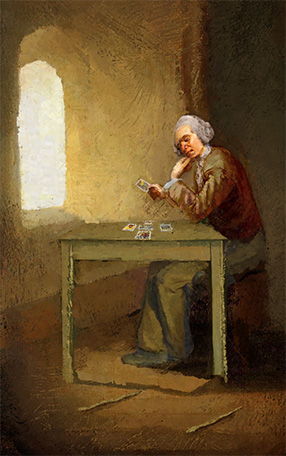Antoine Court de Gébelin

Antoine Court, who named himself Antoine Court de Gébelin (Nîmes, January 25, 1725 – Paris, May 10, 1784), was a Protestant pastor, born at Nîmes, who initiated the interpretation of the tarot as an arcane repository of timeless esoteric wisdom in 1781.
Court de Gébelin, who adopted the surname of his grandmother, was a literary man of recognized rank, and rendered excellent service, first as his father's literary assistant and assistant and afterward as a scholar at the capital. He is remembered in connection with the case of Jean Calas, by his work Les Toulousaines, ou lettres historiques et apologétiques en faveur de la religion réformée (Lausanne, 1763).
Although he was not an occultist, Court de Gébelin's legacy is completely overshadowed by his short discourse on the history of the tarot and its usage as a divination tool.
Early life
His father was Antoine Court, a famous religious leader of the Huguenots. Court de Gébelin had been ordained a pastor in 1754 before departing Switzerland and remained openly Protestant, a rational advocate for freedom of conscience in Enlightenment France. In Paris, he was initiated into Freemasonry at the lodge Les Amis Réunis, in 1771, and moved on to the lodge Les Neuf Sœurs where he welcomed Benjamin Franklin as a lodge-brother.
Career
He was a supporter of American Independence who contributed to the massive Affaires de l'Angleterre et de l'Amérique, of the new theories of economics, and of the "animal magnetism" of Franz Mesmer.
His great project had for its goal to set out to reconstruct the high primeval civilization. Reinterpreting Classical and Renaissance evocation of the Golden Age in mankind's early history, Court de Gébelin asserted that the primitive worldwide civilization had been advanced and enlightened. He is the intellectual grandfather of much of modern occultism. His centers of focus are the familiar ones of universal origins of languages in deep time and the hermeneutics of symbolism. While his views on hermeneutics and religious matters were largely conservative, his original ideas and research on the origin of language earn him a place among pioneers of linguistics.
Court de Gébelin presented dictionaries of etymology, what he called a universal grammar, and discourses on the origins of language. His volumes were so popular he republished them separately, as Histoire naturelle de la parole, ou Précis de l'Origine du Langage & de la Grammaire Universelle ("Natural History of Speech, or a Treatise on the Origins of Language and of Universal Grammar"), in Paris, 1776.
With regard to mythology and symbology, he discussed the origins of allegory in antiquity and recreated a history of the calendar from civil, religious, and mythological perspectives.
Tarot
De Gébelin wrote an essay included in his Le Monde primitif, analysé et comparé avec le monde moderne ("The Primeval World, Analyzed and Compared to the Modern World"), volume viii, 1781. The chapter on Tarot with which his name is indelibly associated is a single section in his vast compendium that he published in series from 1773, to a distinguished list of subscribers, headed by Louis XVI of France.
It was his immediate perception, the first time he saw the Tarot deck, that it held the secrets of the Egyptians. Writing without the benefit of Champollion's deciphering of the Egyptian language, Court de Gébelin developed a reconstruction of Tarot history, without producing any historical evidence, which was that Egyptian priests had distilled the ancient Book of Thoth into these images.
These they brought to Rome, where they were secretly known to the popes, who brought them to Avignon in the 14th century, whence they were introduced into France. An essay by the Comte de Mellet included in Court de Gebelin's Monde primitif is responsible for the mystical connection of the Tarot's 21 trumps and The Fool with the 22 letters of the Hebrew alphabet.
An essay appended to this gave suggestions for cartomancy; within two years the fortune-teller known as "Etteilla" published a technique for reading the tarot, and the practice of tarot reading was born.